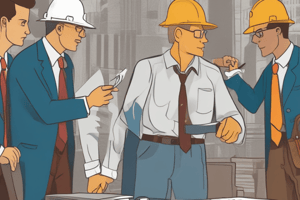Podcast
Questions and Answers
What is the primary reason workers organize into unions?
What is the primary reason workers organize into unions?
- To increase the number of work hours
- To decrease workplace communication
- For better wages and benefits (correct)
- To obtain better management
Union membership in the U.S. has increased over the past decade.
Union membership in the U.S. has increased over the past decade.
False (B)
What is one example of unfair employer practices in labor law?
What is one example of unfair employer practices in labor law?
Discriminating against union members.
Workers seek protection from ________ whims of management.
Workers seek protection from ________ whims of management.
Match the following terms with their definitions:
Match the following terms with their definitions:
Which act protects the right to collective bargaining?
Which act protects the right to collective bargaining?
The Taft-Hartley Act of 1947 prohibits unfair union labor practices.
The Taft-Hartley Act of 1947 prohibits unfair union labor practices.
What are the three layers of the American Federation of Labor and Congress of Industrial Organizations (AFL-CIO)?
What are the three layers of the American Federation of Labor and Congress of Industrial Organizations (AFL-CIO)?
The _______ prohibits employers from interfering with the right of self-organization.
The _______ prohibits employers from interfering with the right of self-organization.
Match the following laws with their key features:
Match the following laws with their key features:
Which of the following is NOT one of the employer practices prohibited by the Wagner Act?
Which of the following is NOT one of the employer practices prohibited by the Wagner Act?
The Change to Win Coalition is a governmental organization.
The Change to Win Coalition is a governmental organization.
List two examples of unfair union practices addressed by the Taft-Hartley Act.
List two examples of unfair union practices addressed by the Taft-Hartley Act.
Which of the following is NOT a type of bargaining item?
Which of the following is NOT a type of bargaining item?
The grievance procedure is designed to create an environment where grievances never arise.
The grievance procedure is designed to create an environment where grievances never arise.
What is the tendency regarding the length of contract agreements today?
What is the tendency regarding the length of contract agreements today?
The process of resolving disputes with the assistance of a neutral third party is known as __________.
The process of resolving disputes with the assistance of a neutral third party is known as __________.
Which of the following is a source of third-party assistance in resolving disputes?
Which of the following is a source of third-party assistance in resolving disputes?
Union membership is currently on the rise in the United States.
Union membership is currently on the rise in the United States.
Name one action unions are taking to address declining membership.
Name one action unions are taking to address declining membership.
Which of the following tactics can help a union win an election?
Which of the following tactics can help a union win an election?
It is acceptable for a supervisor to spy on employees during union activities.
It is acceptable for a supervisor to spy on employees during union activities.
What is the legal process for employees to terminate a union’s right to represent them called?
What is the legal process for employees to terminate a union’s right to represent them called?
The law requires management and labor to negotiate in good faith regarding wages, hours, terms, and __________.
The law requires management and labor to negotiate in good faith regarding wages, hours, terms, and __________.
Match the following practices regarding unions with their definitions:
Match the following practices regarding unions with their definitions:
Which of the following is NOT a recommended supervisory action regarding unions?
Which of the following is NOT a recommended supervisory action regarding unions?
The collective bargaining process is required by law to be conducted in good faith.
The collective bargaining process is required by law to be conducted in good faith.
Name one issue that unions emphasize to build worker commitment during campaigns.
Name one issue that unions emphasize to build worker commitment during campaigns.
Which of the following is NOT a prohibited union practice under the Taft-Hartley Act?
Which of the following is NOT a prohibited union practice under the Taft-Hartley Act?
The Landrum-Griffin Act includes a Bill of Rights for union members.
The Landrum-Griffin Act includes a Bill of Rights for union members.
Name one right that employers must uphold during union activities.
Name one right that employers must uphold during union activities.
The process of collecting employee endorsements for union representation typically starts with obtaining __________.
The process of collecting employee endorsements for union representation typically starts with obtaining __________.
Match the following steps in the union drive to their descriptions:
Match the following steps in the union drive to their descriptions:
According to the regulations, what is one major requirement during the election process?
According to the regulations, what is one major requirement during the election process?
Employees are prohibited from being coerced by unions during union drives.
Employees are prohibited from being coerced by unions during union drives.
What must a supervisor avoid doing during the union drive?
What must a supervisor avoid doing during the union drive?
Flashcards
Current Union Membership
Current Union Membership
Union membership has declined, with approximately 14 million workers in the U.S. currently belonging to unions.
Why do workers organize?
Why do workers organize?
Unions are formed by employees to collectively bargain with employers for better working conditions, pay, and benefits.
Fair Share of the Pie
Fair Share of the Pie
Unions aim to ensure workers receive a fair share of the company's profits, often through collective bargaining negotiations.
Protection from Arbitrary Management
Protection from Arbitrary Management
Signup and view all the flashcards
Poor Employee Relations
Poor Employee Relations
Signup and view all the flashcards
Union Security
Union Security
Signup and view all the flashcards
Right to Work
Right to Work
Signup and view all the flashcards
Unions' goals
Unions' goals
Signup and view all the flashcards
Period of Strong Encouragement
Period of Strong Encouragement
Signup and view all the flashcards
Key Acts during the Period of Strong Encouragement
Key Acts during the Period of Strong Encouragement
Signup and view all the flashcards
Period of Modified Encouragement (Coupled with Regulation)
Period of Modified Encouragement (Coupled with Regulation)
Signup and view all the flashcards
Key Act during the Period of Modified Encouragement
Key Act during the Period of Modified Encouragement
Signup and view all the flashcards
Unfair Employer Labor Practices
Unfair Employer Labor Practices
Signup and view all the flashcards
Five Unfair Employer Practices
Five Unfair Employer Practices
Signup and view all the flashcards
Examples of Unfair Employer Practices
Examples of Unfair Employer Practices
Signup and view all the flashcards
Period of Detailed Regulation of Internal Union Affairs
Period of Detailed Regulation of Internal Union Affairs
Signup and view all the flashcards
Refusing to bargain in good faith
Refusing to bargain in good faith
Signup and view all the flashcards
Employer's obligation during union drives
Employer's obligation during union drives
Signup and view all the flashcards
Landrum-Griffin Act's impact on unions
Landrum-Griffin Act's impact on unions
Signup and view all the flashcards
Union restrictions regarding employees
Union restrictions regarding employees
Signup and view all the flashcards
Authorization card
Authorization card
Signup and view all the flashcards
Bargaining unit
Bargaining unit
Signup and view all the flashcards
Management's role during a union drive
Management's role during a union drive
Signup and view all the flashcards
Union election process
Union election process
Signup and view all the flashcards
What are some common management mistakes that can lead to unionization?
What are some common management mistakes that can lead to unionization?
Signup and view all the flashcards
What is decertification?
What is decertification?
Signup and view all the flashcards
How do unions approach elections?
How do unions approach elections?
Signup and view all the flashcards
What are the limitations on supervisor's communication during a union election?
What are the limitations on supervisor's communication during a union election?
Signup and view all the flashcards
What is Collective Bargaining?
What is Collective Bargaining?
Signup and view all the flashcards
What are examples of bargaining 'not in good faith'?
What are examples of bargaining 'not in good faith'?
Signup and view all the flashcards
Do employees have the right to remove a union?
Do employees have the right to remove a union?
Signup and view all the flashcards
What is a union's 'first contract' strategy?
What is a union's 'first contract' strategy?
Signup and view all the flashcards
Impasse in Bargaining
Impasse in Bargaining
Signup and view all the flashcards
Mediator in Labor Relations
Mediator in Labor Relations
Signup and view all the flashcards
Fact-Finder in Labor Relations
Fact-Finder in Labor Relations
Signup and view all the flashcards
Arbitration in Labor Relations
Arbitration in Labor Relations
Signup and view all the flashcards
Strike in Labor Relations
Strike in Labor Relations
Signup and view all the flashcards
Labor Contract
Labor Contract
Signup and view all the flashcards
Grievance Process
Grievance Process
Signup and view all the flashcards
Cooperative Labor Relations
Cooperative Labor Relations
Signup and view all the flashcards
Study Notes
Chapter 15: Labor Relations and Collective Bargaining
- This chapter focuses on labor relations and collective bargaining in Human Resource Management.
- The number of US workers belonging to unions is about 14 million, which is down. Union membership still represents about 11% of the total workforce.
- Workers organize for various reasons, including pay (wanting a fair share of the profits), protection from arbitrary management decisions, poor employee relations (low morale, fear of job loss, and poor communication), and other factors.
- A modern survey study indicates that focusing on employee engagement can foster positive relationships between employees and management, therefore decreasing the likelihood of unionization.
- Unions commonly seek union security (right to work, banning union membership as a condition of employment), improved wages, hours, and benefits.
- The AFL-CIO and the SEIU (Service Employees International Union) are prominent organizations in the American labor movement, along with the Change to Win Coalition.
- Labor laws have evolved through three distinct periods: strong encouragement, modified encouragement coupled with regulation, and detailed regulation of internal union affairs.
- The Norris-LaGuardia Act (1932) supported the right to collective bargaining, made yellow-dog contracts unenforceable, and limited court's stop order abilities.
- The Wagner Act (1935) established fair labor practices, mandated secret ballot elections, and created the National Labor Relations Board (NLRB).
- The Wagner Act prohibits five employer practices: interference with self-organization, dominating union formation, discriminating against union members, discriminating for filing unfair charges, and refusing to bargain collectively.
- The Taft-Hartley Act (1947), also known as the Labor Management Relations Act, prohibited unfair union labor practices, enumerated employee and employer rights, and allowed the US President to temporarily bar national emergency strikes.
- Unfair union labor practices include restraining/coercing employees from exercising bargaining rights, causing an employer to discriminate, refusing to bargain in good faith, and participating in featherbedding.
- Employees' rights include protection from union coercion. Employers must avoid threats, promises, coercion, and interference with workers.
- The Landrum-Griffin Act (1959) established rules for internal union affairs and a bill of rights for union members.
- Supervisors should not threaten, interrogate, or make promises to employees during union drives and elections. They can provide fair facts, opinions, rules, and experiences about unions.
- Union drives typically involve initial contact (labor relations consultants, union salting, and public pressure), obtaining authorization cards, holding hearings to determine bargaining units, campaigns from both sides, and secret ballot elections.
- Mistakes that lead to losing an NLRB election may include insufficient attention to the election, neglecting committees, focusing excessively on money or benefits, or poor delegation to divisions.
- Strategies to win an NLRB election include focusing on slow, grassroots organizing, building active rank-and-file participation, pursuing first-contract settlements quickly, encouraging worker commitment and using pressure tactics.
- The collective bargaining process requires good faith negotiations between management and labor, costing the union's demands accurately, and engaging in voluntary, mandatory, and illegal bargaining items.
- Handling disputes and grievances effectively often involves creating a healthy environment where such situations are less likely to arise.
- Contract agreements often range from 20 to 30 pages and may include detailed rules, policies or a mix.
- Decertification elections allow employees to remove a union's role. Decertification campaigns often mirror certification efforts.
Learning Objectives
- Key learning objectives for Chapter 15 are presented, including specific topics such as American labor movement history, unfair labor practices (for both employers and unions), supervisor conduct during union drives and elections, understanding bargaining that is not in good faith, developing a grievance procedure, and knowing examples of cooperative labor relations.
Studying That Suits You
Use AI to generate personalized quizzes and flashcards to suit your learning preferences.





